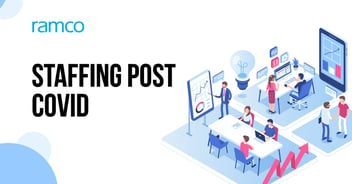

How ready are you?
The Face of the Worker is Changing
Workforce Management and workforce solutionsare an imperative today. That’s because the days when a person would wake up, shower, drive to his workplace, get behind the desk (or on the sales field) by nine in the morning, break for lunch at one in the afternoon, and then be on his/her way back home at five in the evening, are slowly and increasingly becoming a thing of the past. The way we work is changing. Alternative workforce is more common, and organisations need a wider spectrum of working models (and consequently workforce solutions) to managefull-time salaried employees, contract workers, and freelancers. A report by Deloitte[1]finds that only 42% of the organisations it surveyed are made up of salaried employees, whereas 77 million people are formally identified as freelancers in the U.S., Europe and India. These freelancers and contractual workers are different from their predecessors. They are geographically dispersed, have varied career aspirations and their motivations are different from the previous generations.
The traditional employer-employee relationship is undergoing a shift. Employers now have the flexibility of exploring the potential of different economic models in sourcing talent. Planning and optimising solutions to manage such a workforceis now a mandate of both the HR and business leaders. Add to this the pressure to move faster in finding new skills, especially on-demand, means that both the policies and the processes involved have to be fit in working with this contract workforce.
A System riddled with Challenges
While engaging with a contract workforce gives the flexibility to attract skilled expertise, address seasonal demands or control labour costs, most companies are not really ready for it. Deloitte finds that only 16% of the respondents have an established set of policies and practices to manage the variety of worker types, pointing to an enormous gap in capabilities. To get real value from this ecosystem, organisations need to understand how to appeal to these workers, how to manage them and most importantly, how to keep them engaged and make them feel an integral part of the entire “employee” community, while facing inward – the organizations also need to be nimble with their expectations, objective setting, tracking and engagement with the contract workforce & freelancers as traditional engagement, performance metrics and communications models don’t fit.
The system, however, is riddled with challenges.
- There is an opportunity cost involved for organisations that fail to capitalise on adequate work arrangements for the contract workers.
- There are very few consistent tactical strategies in place and are mostly handled by the procurement (and not the HR) department.
- Traditionally, the HR software market does not have in-built workforce management solutiontools to equip managers with a way to handle this emerging workforce.
- Non-traditional workers can prove to be difficult to manage from a project, talent, delivery and budget perspective.
- Only few companies track these workers’ compliance with their contracts/SOWs, effectively.
- New workforce models come with new risks - legal, security, privacy. There could be a loss of confidentiality. There is a reputational risk involved, arising from a negative perception of non-traditional workers. Changing government regulations can further add to the hassles of managing these workers.
A Holistic Contract Workforce Management SolutionCan Change the Game
Managing the contract workforce needs a holistic solutionthat can enforce proper control and enable complete management of every single worker that is a part of the ecosystem.
There are a few things we believe to be vital for the success of such a program.
- The speed with which talent is engaged and brought into the organisation is critical.
- Adequate collaboration needs to take place between the internal functions in the organisation such as HR, Learning & Development and procurement.
- All levels of compliance for the contract workers need to be integrated into the system so that there is no scope for miscommunication.
- All day-to-day operations need to be standardised in a central on-demand system.
- Both onboarding and offboarding processes need to be comprehensive and automated with seamless workflow processes.
- Re-imagine delivery quantity and qualification methodologies and processes
- Standard company-wide data privacy & security procedures need to be a part of the system
- All functionalities related to vendor management must be included, with essential self-service functions exposed to the vendors in the eco-system.
Stay Sane & Level Up with a Workforce Solution
Technology has always been a game-changer, no matter which industry. The same holds true for the Contract Workforce segment too. Digitization, Collaboration and Automation can go a long way in keeping and managing the workforce, no matter how diversely located, by giving you a seamless system for managing the operations.
Here are some ways in which this can work to your advantage.
- Benefit from the quick response and turnaround time for meeting client staffing demands
- Secure authenticity of contract workers
- Provide multi-various engagement channels (Mobility, Bots etc.) for the contract workers
- Seamlessly reconcile with vendors
- No delays in pay-outs
- Easily manage statutory compliance
- Most importantly, revenue leakages are to be plugged
Gear Up For This Powerful Business Force
We understand the future of work is going to be different from what we see at present; there’s going to be a more innovative engagement of talent, mobile-optimized work will become popular, a flexible workspace will become the norm and a blended workforce with shared objectives will take shape.
A transformative shift in business thinking is needed if one is to successfully embrace the future of talent. There is no escaping the fact that, in the time to come, more millennials and centennials are going to choose to take advantage of the flexibility provided by alternate work models. As a business that aims to scale and grow its revenue, you need to not only understand how this workforce operates but also deploy and integrate systems at the back-end to extend your capabilities of engaging with these new-age workers.
The better prepared you are, the better your workforce (Permanent and Contract both) will be able to provide you with quality work and stay productive, instead of having to chase you for payments, or for you having to chase them for leakages in deadline, quality or compliance
Frequently Asked Questions (FAQs)
Enterprise asset management (EAM) involves the management of mission critical assets of an organization throughout each asset's lifecycle. EAM is used to plan, optimize, execute, and track the needed maintenance activities with the associated priorities, skills, materials, tools, and information. The aim is to optimize the quality and utilization of assets throughout their lifecycle, increase productive uptime and reduce operational costs.
Enterprise asset management (EAM) involves the management of the maintenance of physical assets of an organization throughout each asset's lifecycle. EAM is used to plan, optimize, execute, and track the needed maintenance activities with the associated priorities, skills, materials, tools, and information.
The software helps in effective maintenance of assets through preventive, predictive, shutdown and breakdown maintenance strategies. The system also helps enterprises mitigate equipment risks by enhanced safety standards. The streamlined operations and improved asset performance helps organizations increase their investment effectiveness.
EAM is important because it helps organizations track, assess, manage and optimize asset quality and reliability. Asset intensive Organizations have hundreds, thousands, even millions of assets which needs to be maintained to maximize / optimize life of these assets to increase the return on investment.
The key features of effective EAM are:
- Work management.
- Maintenance Strategies (Preventive/ Predictive / Breakdown / Shutdown).
- Planning and scheduling.
- Supply chain management.
- Health and safety.
- Mobility.
- Analytics.
- Improved Asset Health at reduced cost through data driven maintenance Programs
- Complete visibilityon entire maintenance data across Equipment, across Models, across Branches to aid in analysis & decision making such as to Repair or Replace the Equipment
- Insightful analysis of Inspection Data to improve customer satisfaction
- Effective maintenance management enhanced by predictive maintenance and inbuilt analytics
- Increased reliability and safety, keeps complete track of all the inspections & calibration schedules
- Mobile Application enables users to execute work while “in the field” leading to minimized non-productive time and increased productivity and reduces duplication of work and human errors in recording information.
- Quick turnaround time through Actionable Notification & Alerts for every process in real time and accessible anytime and anywhere.
- Improved Regulatory Part of asset management involves the implementation of better O&M practices, which can significantly improve compliance.
Asset Intensive companies under the following Industries :
- Ports
- Cement and Mining
- Utilities
- Fleet Maintenance
- Equipment Rental
- Other Manufacturing
- Real Estate & Infrastructure
- Power Generation
Contact us for a meeting and schedule a demo
This differs on case to case basis, based on the type of installation and unique industry specific requirements. Contact us for a meeting and schedule a demo.
This differs on case to case basis, based on the type of installation and unique industry specific requirements. Contact us for a meeting and schedule a demo.
Stay Connected, follow us on LinkedIn / Twitter to know more about EAM Software latest trends.


